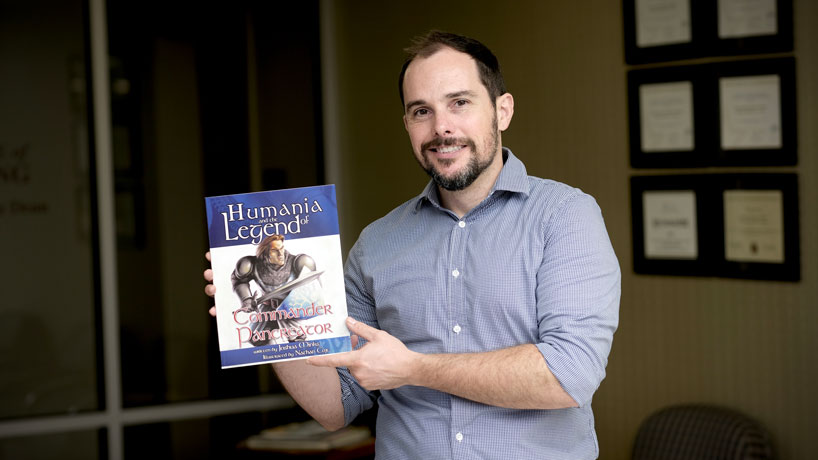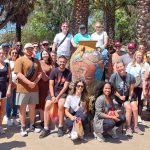
In “Humania and the Legend of Commander Pancreator,” nursing Assistant Teaching Professor Joshua Minks describes the onset of Type 1 diabetes in story form. (Photo by August Jennewein)
While working as a pediatric nurse before switching to teaching full-time, Joshua Minks remembers listening to the challenges that health departments and diabetes clinics were having educating children newly diagnosed with the condition and, in turn, reflecting on his own experiences with the disease.
Minks, who recently joined the University of Missouri–St. Louis College of Nursing as an assistant teaching professor, is a 2019 graduate of UMSL’s PhD program, and his dissertation focused on Type 2 diabetes. But he has a personal connection to the disease, too, having been diagnosed with Type 1 diabetes at age 12.
He remembered having lots of questions upon his diagnosis – Why? How? What happened? – but having difficulty expressing those queries about the disease to the clinical staff at the hospital. As he thought about these memories alongside his interactions working with children later in life as a nurse, an idea was born.
Minks decided to create a children’s book that would describe the disease process in the form of a story in order to help young people understand it in a simpler context. In “Humania and the Legend of Commander Pancreator,” which was published in 2010, Minks describes the onset of Type 1 diabetes through the tale of Commander Pancreator, who must defend Humania against the restless Glucosites. He uses the setting of Humania to represent the human body and then introduces different characters to portray the organs that are affected by the disease process. Members of Commander Pancreator’s force, for instance, are known as Langerhans – immune system cells – while T cells are portrayed through the Nine Knights of T’cel.
“The book introduces the characters at the beginning, so the child can understand the terms – especially three-syllable or longer words – just to be able to know how to pronounce them and also so they understand what role the character can play in the book,” he said. “And then each chapter goes through the process from onset: the second chapter is complications, and the third chapter is treatment. The way the chapters of the book unfold, basically, describes each phase in the disease process and then how the disease is treated or managed.”
Minks found it cathartic to write the book, but he was also struck by just how much it could help other people dealing with the disease. He was working at a children’s hospital when he wrote “Humania and the Legend of Commander Pancreator” and volunteered to help at a diabetes camp, where all the kids were given a copy of the book. When he returned to the camp in the following years, the kids remembered him and told him they still had their copies.
“It was pretty special to be able to share that with them,” he said.
Emboldened by the reaction to “Humania and the Legend of Commander Pancreator,” Minks decided to expand the book into a series. His second book in the Humania series, which has been written but is still in the production process, centers on muscular dystrophy. Since Minks doesn’t have a personal connection to the disease, he interviewed a former patient, Eric, from the children’s hospital and used his experience to inform the storyline. In addition to describing what it’s like to live with muscular dystrophy, the book incorporates details from Eric’s own personal life, such as his desire to become an accountant when he grows up.
Minks hopes the series can help children who are diagnosed with diseases – along with their friends and family – better understand the experience by presenting it in a way that is at once compelling and easy to understand.
“It’s hard to find fun being diagnosed with diabetes, speaking from experience, but you can have an interesting way to look at the disease and how it affects the body,” he said. “In turn, you can have connections with peers and family members who maybe don’t understand. So as the child lives the disease process, and they want someone else to be able to understand, they can have a common language that they can share, they can read the book together, they can provide it as a resource and say, ‘This is kind of what it’s like.’”
“Humania and the Legend of Commander Pancreator” is available for purchase through Amazon, Barnes & Noble and Google Books.














